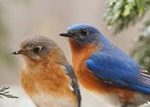Placing a Bluebird Nest Box
go.ncsu.edu/readext?655965
en Español / em Português
El inglés es el idioma de control de esta página. En la medida en que haya algún conflicto entre la traducción al inglés y la traducción, el inglés prevalece.
Al hacer clic en el enlace de traducción se activa un servicio de traducción gratuito para convertir la página al español. Al igual que con cualquier traducción por Internet, la conversión no es sensible al contexto y puede que no traduzca el texto en su significado original. NC State Extension no garantiza la exactitud del texto traducido. Por favor, tenga en cuenta que algunas aplicaciones y/o servicios pueden no funcionar como se espera cuando se traducen.
Português
Inglês é o idioma de controle desta página. Na medida que haja algum conflito entre o texto original em Inglês e a tradução, o Inglês prevalece.
Ao clicar no link de tradução, um serviço gratuito de tradução será ativado para converter a página para o Português. Como em qualquer tradução pela internet, a conversão não é sensivel ao contexto e pode não ocorrer a tradução para o significado orginal. O serviço de Extensão da Carolina do Norte (NC State Extension) não garante a exatidão do texto traduzido. Por favor, observe que algumas funções ou serviços podem não funcionar como esperado após a tradução.
English
English is the controlling language of this page. To the extent there is any conflict between the English text and the translation, English controls.
Clicking on the translation link activates a free translation service to convert the page to Spanish. As with any Internet translation, the conversion is not context-sensitive and may not translate the text to its original meaning. NC State Extension does not guarantee the accuracy of the translated text. Please note that some applications and/or services may not function as expected when translated.
Collapse ▲
Eastern Bluebird
Photo by NC Bluebird Organization
It’s nearly Spring and the birds will soon be actively gathering material to build their nests. One of the most beloved birds known for their vivid blue color and sweet song is the Eastern Bluebird.
One way to attract bluebirds to your yard is to provide a nest box. Bluebirds prefer a nesting box with a hole either 1 ½ inches in diameter round or 2 ¼ inches tall and 1 3/8 inches wide oval. They like an open habitat of fields or lawns with sparse trees. You’ll want to place a nesting box in an environment they prefer. A word of caution: Golf courses, cultivated fields, gardens, and yards are potentially good habitats for nest boxes, but avoid areas where pesticides and herbicides are used. These are not only harmful to birds, they decrease and sometimes eliminate the insect populations that are the primary food source for many cavity-nesting species.
Nesting boxes should be placed on a pole about 3 – 6 feet in height with a predatory guard to prevent cats, snakes and other predators from getting to the nest. The box should face the open area with the opening facing away from the prevailing winds, preferably to the southeast. Mount the box in such a way that it can easily be removed for repairs when needed.
For more information visit the North Carolina Bluebird Society or NestWatch.
Written by Marcee Rollandi, Master Gardener Volunteer




